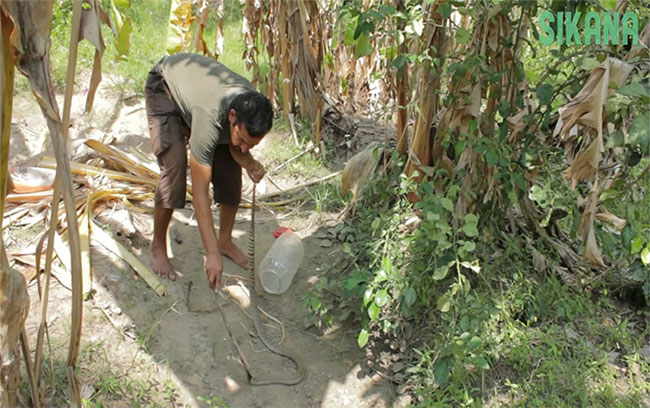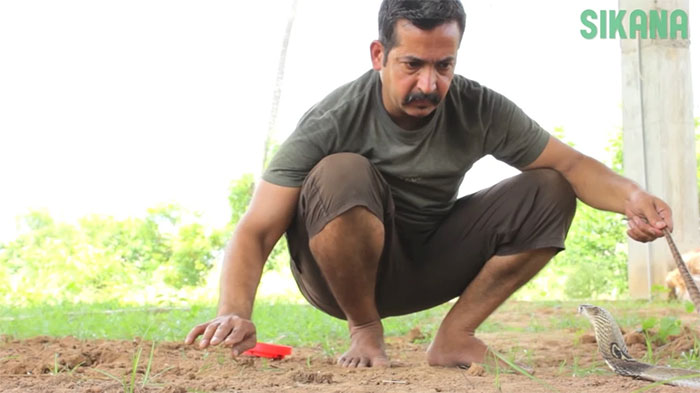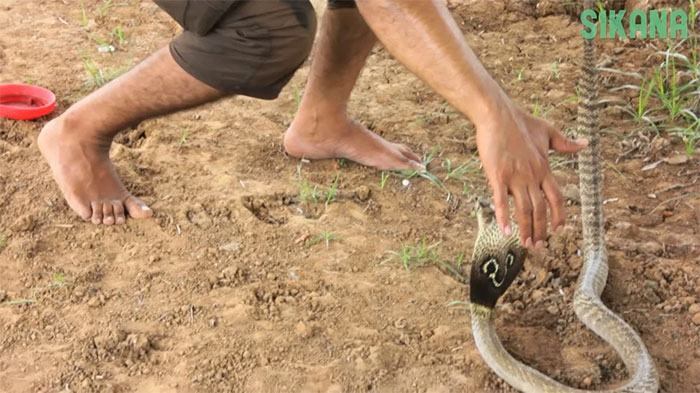This article provides scientific knowledge and does not encourage imitation, as this is an extremely dangerous action.
The Secrets of Catching Cobras by Experts
We often see experts or snake catchers handling wild cobras with remarkable ease and gentleness. During the catching process, these individuals employ numerous movements as if they are hypnotizing the snake.
So, have you ever wondered about the significance of these movements? Let’s decode their meaning in the article below:
When faced with a snake, we often feel a primal fear (Ophidiophobia, or the fear of snakes, statistics show that 1 in 3 adults suffer from this phobia) because many snakes possess lethal venom.
However, experts indicate that snakes are often more afraid of us than we are of them. Therefore, it is essential to remain calm to avoid provoking the snake. The snake catcher must maintain eye contact with the snake; even a moment of distraction can lead to severe consequences.
How to Catch a Cobra
Even the most skilled and experienced snake catchers can get bitten if they are complacent or do not follow the rules below:
Always hold the snake’s tail firmly while keeping your body relaxed and lowering your center of gravity (being too large can make the snake feel threatened and agitated). Additionally, maintain as much distance from the snake as possible (some cobras can strike quickly and spit venom).

Catching a cobra with a long stick. (Photo: Cut from the video in the article)
Avoid causing pain to the snake; instead, be gentle throughout the catching process. Next, use a long stick or any long object to gently press down on the snake’s head while slowly lifting it by the tail.
Note: The amount of pressure applied to the snake’s head should depend on its size; however, all actions must be gentle to avoid making the snake feel threatened. If you’re too gentle, you might lose hold of the snake’s head and get bitten.
Once you have pinned the snake’s head to the ground, release your grip on its tail and use that hand to secure the snake’s neck (hold it as close to the head as possible to prevent the snake from turning and biting your hand). You must grip firmly yet gently to avoid suffocating the snake.
When placing the snake into a bag or box, it must be done very carefully. Gently lower the snake’s tail into the container first, followed by its head. The motion should be quick and decisive! During the catching process, snake catchers or experts may perform the following supportive actions:
Decoding the Body Language of Snake Catching Experts
Step 1: Calming the Snake
Slowly extend your hands in front of the snake to calm it down, tapping your fingers lightly on the ground to signal that you are not a threat. The cobra will gradually lower its head when it feels safe.

Using hands to attract attention and calm the snake. (Photo: Cut from the video in the article).
Continuously use your fingers to attract the snake’s attention while observing its reactions (if the snake lifts its neck and flares its hood, hissing, it is angry and preparing to attack). Absolutely avoid sudden movements that might startle the snake.
Step 2: “Hypnotizing” the Snake with Your Knee and Hand
When seated, snake-catching experts often sway their knee back and forth to distract the snake’s attention. This will free their hands to gently place on the snake’s head, a technique that requires confidence and experience to execute.

Using the knee to attract the snake’s attention while one hand goes above the snake’s head. (Photo: Cut from the video in the article)
If you move your foot instead of your knee, the snake will sense danger and retreat (because they have a special organ to detect vibrations). This action is often used to ensure the snake moves away from the body of the catcher for safety.
Note: When performing this action, keep both feet on the ground and avoid moving backward too quickly; the snake may become startled and attack.
The above outlines the significance of the movements that knowledgeable and experienced snake catchers often use; readers should not attempt to imitate these actions to avoid potential accidents.


















































